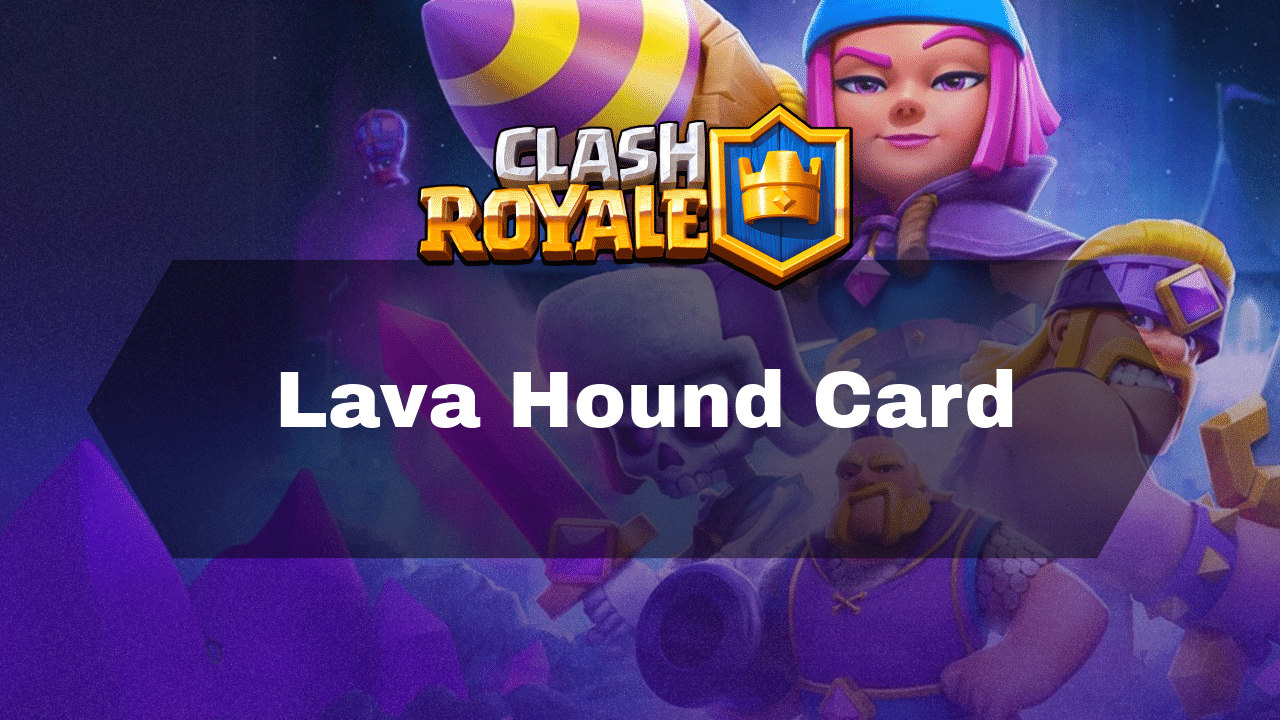
Introduction
Lava Hound Elixir Cost 7 Rarity Legendary Type Troop Arena Rascal’s Hideout Release Date3 May 2016The Clash Royale Lava Hound is a Legendary air troop that targets only buildings and costs 7 Elixir to deploy. As an air unit, it can only be attacked by troops and buildings that target air, giving it resilience against many ground-based counters. It stands out as one of the few multi-stage units in the game, alongside the Golem, meaning it continues to pose a threat even after its initial form is destroyed.
At tournament standard, the Lava Hound has 3581 hitpoints, while at level 1 it begins with 3150 HP. This exceptional health pool makes it a powerful tank, capable of soaking up extensive damage while slowly pushing toward enemy towers. Despite its size and cost, the Lava Hound deals very low damage—only 45 per hit at level 1—with a hit speed of 1.3 seconds, resulting in a damage-per-second (DPS) of just 34. It has a range of 2 and moves at a slow speed of 45, with a 1-second deploy time.
Upon death, the Lava Hound splits into six Lava Pups that fan out and continue the assault. Each Lava Pup has 179 hitpoints at level 1—comparable to a Minion—and deals 45 damage per hit, with a hit speed of 1 second, giving them a DPS of 45. Unlike the Lava Hound, the Pups target both air and ground units, making them far more versatile and dangerous if ignored. However, they are vulnerable to low-damage spells and area attacks due to their low health.
The Lava Hound is widely considered a strong win condition, especially in air-focused Beatdown decks. These decks prioritize building an Elixir advantage to create a powerful push, usually starting with a Lava Hound behind the King Tower to give time to build support. Typical support includes a mix of air troops, with only minimal ground presence used for defense or distractions. This slow-paced, high-commitment playstyle often requires players to absorb damage on their own towers in exchange for a stronger offensive.
While the Lava Hound lacks versatility compared to other Legendary cards and demands a deck tailored specifically around it, it excels in its role. Its presence and popularity have grown, especially with the introduction of Royal Chef, a Tower Troop that can enhance support troops and synergizes well with the Lava Hound’s push potential.
Card Attributes
Lava Hound Attributes Default Slowing Effect Rage Effect Cost Hit Speed First Hit Speed Speed Deploy Time Range Projectile Speed Target Count Transport Type Rarity 7 1.3 sec 1 sec Slow (45) 1 sec 3.5 400 Buildings x1 Air Troop Legendary Lava Pup Attributes Hit Speed First Hit Speed Speed Range Projectile Speed Target Count Transport 1.7 sec 1 sec Medium (60) Melee: Long (1.6) 500 Air & Ground x6 Air Level Lava HoundHitpoints Lava Hound
Damage Lava Hound Damage per second Lava Pup
Hitpoints Lava Pup
Damage Lava Pup
Damage per second
Card Mastery
Type Level/Tier Objective RewardDamage Dealer 1 Deal a total of 130,000 Damage to enemy
Troops or buildings 2 Lava Hound cards
100 2 Deal a total of 385,000 Damage to enemy
Troops or buildings 8,000
100 3 Deal a total of 650,000 Damage to enemy Troops or buildings 150
100
Pincushion 1 Receive a total of 3,500 hits from enemy Towers 12,000
150 2 Receive a total of 10,000 hits from enemy Towers 200
150 3 Receive a total of 18,000 hits from enemy Towers 18,000
150
Understanding Lava Hound Decks
Understanding Lava Hound decks is essential for mastering their playstyle or effectively countering them in Clash Royale. These decks are built around a Beatdown archetype, which focuses on creating a powerful push by accumulating an Elixir advantage. The Lava Hound itself is the core win condition, acting as a high-health air tank that absorbs damage while escorting support troops. Upon destruction, it spawns Lava Pups that target both air and ground units, capable of dealing significant damage if not addressed quickly.
Lava Hound decks heavily rely on air-based support, using troops like Baby Dragon, Inferno Dragon, or Minions to back up the Hound as it advances. Ground troops are kept to a minimum, often limited to one or two defensive units or utility cards. A standard strategy is to deploy the Lava Hound behind the King Tower to allow time for Elixir regeneration, enabling a gradual buildup of support troops behind it. This slow and methodical approach rewards patience and Elixir management, often requiring players to absorb early damage to build a stronger offensive later in the match.
The introduction of the Royal Chef Tower Troop has added synergy to these decks, as its ability to level up nearby troops complements the Lava Hound’s need for powerful support during a push.
There are several archetypes within the Lava Hound deck family, each with a unique approach. The Duo-Lava Hound deck focuses on two main offensive cards—typically the Lava Hound and one secondary win condition like the Balloon. LavaLoon is a classic example, offering high burst damage if the Balloon reaches a tower. Triple-Lava Hound decks incorporate three win conditions, requiring more defense early but allowing for a versatile and balanced late-game push. Mass-Lava Hound decks use swarm tactics, often with Clone, to overwhelm opponents but can be countered by well-placed spells.
Lava Cycle decks reduce average Elixir cost to cycle back to the Lava Hound faster, enabling more frequent offensive pressure. Lava Beatdown is the traditional style, investing in high-Elixir pushes with tanky and damaging support units. Lava Control decks emphasize defense and selective counter-pushes, using the Lava Hound strategically rather than committing to every offensive opportunity.
Other variations include Lava Miner, which combines the Hound with a Miner to pick off support units or finish towers. Arrow Bait + Hound decks incorporate cheap swarm troops to bait spells like Arrows, protecting key units like Lava Pups. Lava Lightning decks pair the Hound with the Lightning spell to eliminate defenders, clearing the path for Lava Pups and support troops. Lava Double Dragon decks utilize both Inferno Dragon and Baby Dragon for a balanced mix of splash and single-target damage. Lava Lumberjack decks rely on the Rage effect from the Lumberjack’s death to supercharge the push, amplifying the offensive threat of Pups and support units.
Mastering Lava Hound decks requires understanding their slow tempo, managing Elixir efficiently, and making calculated sacrifices in the early game to secure a dominating push in the later stages. Regardless of the variation, the Lava Hound remains the centerpiece—an air tank designed to clear the way for its explosive second phase.
Offensive Strategies with Lava Hound
Lava Hound offensive strategies are built around its role as a high-health air tank, designed to absorb damage while supporting troops deliver the real offensive power. The most common and effective way to initiate an attack is by placing the Lava Hound behind the King Tower, especially in one of the far back corners. This not only allows for better pathing away from centralized buildings but also gives the player time to regenerate Elixir and prepare a layered push. It’s ideal to begin this setup when holding 10 Elixir, ensuring enough resources are available to support the push and defend against potential counter-attacks.
Deploying the Hound during an Elixir advantage can also be effective. A standard tactic is to wait until the Lava Hound crosses the bridge before placing support troops, allowing you to react to your opponent’s defense and optimize placement.
Several offensive combinations are commonly used with the Lava Hound. The LavaLoon strategy pairs the Hound with a Balloon, combining high tankiness with explosive tower damage if the Balloon connects. Lava Miner uses the Miner as a secondary win condition, offering precision targeting for defending support troops or finishing off a tower. Lava Lightning utilizes the Lightning spell to eliminate key defensive troops just before the Hound explodes into Lava Pups. Lava Double Dragon includes both Baby Dragon and Inferno Dragon as support, providing a strong balance of splash and single-target damage. In Lava Lumberjack setups, the Lumberjack’s Rage effect boosts the speed and damage of the push, especially once the Lava Pups spawn.
Arrow Bait Lava Hound decks rely on swarm units like Minions or Minion Horde to draw out spells such as Arrows or Fireball, clearing the way for Lava Pups to survive and inflict damage. Traditional Tank + Hound strategies involve using the Lava Hound to bait air-targeting defenses while supporting with ground units like a Wizard to clear threats. Some faster-paced strategies, like the Tower Rush or “Ninja Lava Hound Push,” use cheap synergy troops like Mega Minion, Goblin Gang, or Electro Wizard to create a rapid, spell-supported push.
Supporting cards are critical to the success of any Lava Hound push. Air troops like Mega Minion, Baby Dragon, and Inferno Dragon can sit safely behind the Hound, protected by its large health pool. Spells play a crucial role—Zap resets Inferno Towers and Inferno Dragons and handles small swarms; Arrows and Fireball deal with Minions, Princess, or grouped troops; Lightning clears high-value targets like Musketeer and Electro Wizard; and Poison provides sustained control against buildings and swarms. Some decks also incorporate ground support like the Miner for chip damage and targeting ranged defenders, or the Lumberjack for its Rage effect. Defensive buildings such as Tombstone can contribute to counter-pushes after luring enemy troops.
Advanced tactics include managing commitment timing carefully—holding back damage-dealing support cards like Balloon until after scouting your opponent’s first line of defense. Spell baiting with low-cost air troops can create openings for Minion Horde or Lava Pups. Counter-pushing with surviving defensive troops behind a newly deployed Lava Hound is a powerful transition strategy. During double Elixir time, more aggressive plays become viable, such as attempting to stack multiple Lava Hounds in one lane to overwhelm the opponent, or quickly shifting pressure to the other lane after securing a tower.
Executing a Lava Hound push requires significant Elixir, so efficient Elixir management is essential. Allowing some early tower damage is often part of the plan to enable a massive late-game push. When timed correctly, these offensive strategies can overwhelm even the most prepared defenses.
Defensive Strategies Against Opponents
Defensive strategy in Lava Hound decks, or when playing against them, revolves around smart Elixir management, card placement, and prioritizing key threats. When piloting a Lava Hound deck, it’s common to accept some tower damage early in the game. Overcommitting to defense can leave you without enough Elixir to support a proper offensive push, so a calculated risk of tower damage is often part of the plan. The primary goal is to maintain enough Elixir to build an effective counter-push, ideally with 3–4 Elixir in reserve after a defense.
Key defensive principles include focusing on stopping your opponent’s win conditions and high-damage support units. Defensive buildings like Tombstone are especially effective, not only because they distract building-targeting units like Hog Rider, Giant, Royal Giant, and Balloon, but also because they generate skeletons to help stall and chip away at enemies. Center placement, three tiles from the river, is optimal for pulling from both lanes. Troops like Mega Minion, Minions, Guards, Skeleton Army, and Mini P.E.K.K.A. are versatile defenders that handle a variety of threats.
Spells like Arrows clear swarms such as Minion Horde; Fireball takes out medium-health troops like Wizard and Witch; Zap resets Inferno effects or stuns charging troops like Prince; and Poison controls space or disables Elixir Pumps.
Against Beatdown decks like Giant or Golem, Tombstone pulls the tank, while high-damage troops or swarms bring it down. Be cautious of splash support like Baby Dragon or Wizard—use spells or the Miner to eliminate them. Against Hog Rider, Tombstone plus swarm troops like Skeleton Army or Guards offers solid defense, though spells like Zap or Log must be anticipated. Elite Barbarians can also be countered with Tombstone and supporting troops like Ice Wizard or Mega Minion. Be careful not to bunch up defenders, as this opens you up to Fireball value.
Bridge Spam decks are countered by fast reaction and central placements. Tombstone paired with swarm units or Minions in varied positions prevents easy spell clears. In Spell Bait matchups, save your Arrows or Zap for key moments and use cheap defenders early on to avoid falling into traps. Against Royal Giant decks, defense comes first—Tombstone or another structure should be played before committing to a Lava Hound push to avoid being overwhelmed.
Individual threats require targeted responses. The Princess is best handled by a Miner or Arrows, but timing matters to avoid wasting spells. Inferno Tower and Inferno Dragon can shut down a Lava Hound; use Zap or Lightning to reset their charge or bait them with Minions. Minion Horde falls to Arrows or a well-placed Fireball. Mega Minion is strong in air-to-air combat and can neutralize many support troops. Executioner is dangerous due to his line splash and should be baited or pushed opposite lane. Three Musketeers demand precise area damage or a split defense using tank and support troops.
For cards like Balloon, use air-targeting troops or buildings to pull it and reduce its threat. The Lumberjack can be neutralized by Mini P.E.K.K.A., while Mighty Miner should not be ignored—Barbarians placed low between the towers can stop him effectively. The Furnace poses a threat to Lava Pups, as its Fire Spirits can destroy them easily; spells like Lightning can be used to eliminate it when it becomes a problem.
Even the Lava Hound itself has defensive utility. Placing it defensively can help separate your opponent’s troops—forcing air units away from ground units—and absorb early damage while buying time. It can also be used to lure and delay pushes, especially if you’re planning a counter-push immediately after surviving an attack.
Adapting your defense to the opponent’s deck, keeping track of their card cycle, and maintaining control over your Elixir are all critical to handling pressure effectively and transitioning into a strong offensive play.
Synergies and Card Combinations
Lava Hound decks thrive on powerful synergies that amplify its role as a high-hitpoint air tank, paving the way for strong follow-up troops and punishing enemy defenses. One of the most iconic and effective combinations is Lava Hound and Balloon (LavaLoon). The Lava Hound soaks up damage while the Balloon follows closely behind, targeting buildings and delivering devastating damage if it connects. Timing is crucial—spacing the two just enough prevents area damage from hitting both at once. When the Hound dies, the Lava Pups clean up surviving defenders, and the Balloon’s death damage can further clear the area.
Another versatile combo is Lava Hound and Miner. The Miner can be deployed to tank for the Lava Pups once the Hound dies, allowing them to lock onto the tower without being distracted by defending troops. The Miner is also excellent for targeting Elixir Pumps or ranged troops like Princess and Musketeer, helping maintain pressure. This synergy is useful both in full pushes and chip cycles.
Mega Minion and Minions are common support units. They offer air-targeting capabilities while benefiting from the Lava Hound’s tanking. Both are cheap, reliable, and effective on both offense and defense, especially in cycling between pushes. Minions can also bait spells like Arrows, creating openings for other swarm units.
The Tombstone complements the Lava Hound defensively by distracting ground troops and providing a stream of Skeletons. It helps slow down enemy tanks or building-targeting units, giving you time to set up a counter-push. It’s a core defensive structure in many Lava decks due to its low cost and reliability.
Spells are essential in Lava Hound decks to handle key counters. Zap resets Inferno Tower and Inferno Dragon, which are some of the most effective counters to the Hound. It also clears out smaller troops like Bats or Spear Goblins. Fireball is ideal for eliminating mid-health defenders like Wizard, Witch, or Three Musketeers. Lightning offers a heavier option that deals with multiple high-value targets at once, such as Musketeer, Electro Wizard, and Inferno Tower, often while damaging the Crown Tower. This synergy is core to the Lava Lightning archetype. Arrows are vital for dealing with Minion Horde or swarm troops that threaten the Lava Pups.
Other valuable support cards include the Baby Dragon, which offers splash damage from the air and supports the Lava Hound push by eliminating swarms. The Lumberjack brings aggressive utility with his high damage and Rage effect on death, which speeds up all nearby units—especially effective when the Lava Hound bursts into Pups. The Ice Wizard can slow enemy pushes and provide additional control.
Several synergistic combinations expand these basic principles. Lava Double Minions adds both Minions and Minion Horde for overwhelming air pressure. Lava Barrel combines Lava Hound, Miner, and Skeleton Barrel to apply pressure on multiple fronts. Airfecta decks focus on using three strong air cards like Lava Hound, Inferno Dragon, and Baby Dragon. Some heavier decks mix in ground support like Valkyrie, Mini P.E.K.K.A., or Prince to balance defense and offense.
Other notable synergies include Freeze plus high-DPS defenders, like Mega Minion, to neutralize a Balloon push. On defense, combinations like Tornado with Executioner or Baby Dragon are especially effective at grouping air units and clearing them in one strike. Tombstone also plays a recurring role as a defensive backbone that contributes to post-defense counter-pushes.
In all combinations, the Lava Hound’s value lies in its ability to soak damage while its teammates deal it. Strong decks use the Lava Hound to draw out air-targeting defenders or spells, then overwhelm with follow-up troops or spells. Most successful Lava Hound strategies include a secondary win condition, reliable air support, splash coverage, a solid spell suite, and a building like Tombstone for defensive stability. These synergies form the backbone of an effective Lava Hound strategy, enabling both steady pressure and explosive tower damage when executed properly.
Specific Lava Hound Decks
Lava Hound
Balloon
Mega Minion
Minions
Tombstone
Fireball
Zap
Guards
The LavaLoon archetype remains the most dominant Lava Hound strategy, combining Lava Hound and Balloon to overwhelm defenses. Standard versions typically include Mega Minion, Minions, Tombstone, Fireball, Zap, and Guards or Goblin Gang as defensive and cycle support. A variation known as LavaLoon V2 replaces some of these cards with Lightning and Arrows for stronger counterplay against air-targeting troops and buildings. Other builds like La-Hut Loon substitute Goblin Gang with Goblin Hut and include Bandit, offering dual-lane pressure and spawn-based chip damage.
In Lava-Miner decks, the Miner is used to tank for Lava Pups or remove backline defenders. Common compositions include Inferno Dragon, Mega Minion, Goblin Gang, Tombstone, Poison, and Arrows, often replacing spells like Fireball with Poison for zone control. Heavier versions integrate the Balloon, Minion Horde, and Fire Spirits for more explosive pushes. Another balanced Lava-Miner build may run Night Witch, Baby Dragon, and Zap for control and splash synergy.
A popular synergy deck is Lava Hound Double Dragon, which features Inferno Dragon and Baby Dragon to cover both single-target and splash damage needs. Often paired with Lightning, this setup can effectively dismantle heavy troops and support units behind tanks. Another hybrid deck, Lava Lightning Prince, builds around Skeleton Dragons, Inferno Dragon, Lightning, and Prince—mixing powerful air pressure with a threatening ground charger.
The Lava Lumberjack variant utilizes the Lumberjack’s Rage effect to boost Lava Pups and support troops post-death. Decks typically include Baby Dragon, Mega Minion, Tombstone, Zap, and Lightning for value trades. A related control deck swaps in Ice Wizard for additional slow and crowd control.
The Lava Cycle or Lava Control archetypes emphasize faster card rotation and sustained pressure. These decks might feature Minions, Mega Minion, Valkyrie, Cannon, Fireball, Arrows, and Zap, allowing quicker access to key responses and consistent chip support. Another variation uses Cannon and Spear Goblins to keep costs low and maintain defensive integrity.
Some decks use unique support combinations. For instance, Phoenix Lava Miner leverages Phoenix’s rebirth and splash capabilities alongside standard LavaMiner components. Lava Loon Heal Beatdown was built around the now-removed Heal spell, focused on sustaining swarm pressure. A similar deck, Lava Loon GobGang Beatdown, includes Goblin Gang for ground control and aggressive counter-pushes.
At mid to lower trophy levels, players often use simpler builds like Lava Hound, Balloon, Minion Horde, Minions, Fireball, Rage, Elixir Collector, Cannon, where Rage amplifies burst damage during a push. Other decks from this range feature Elite Barbarians, Archers, Mini P.E.K.K.A., Goblin Gang, and Zap, blending Lava Hound pressure with strong ground presence.
Some structure-based compositions include Furnace or Goblin Hut as continuous pressure tools, and decks like Lava Hound, Balloon, Tornado, Zap, Tombstone, Ice Wizard, Skeleton Army, Mega Minion blend crowd control and splash synergy. Meanwhile, Lava Barrel decks use Miner, Skeleton Barrel, and fast cycle troops like Spear Goblins or Goblin Gang to apply unpredictable lane pressure.
Advanced players may build around templates like Lava Beatdown, Lava Cycle, or Lava Control, adjusting based on preferred win conditions, defense cores, and counter-response tools. These templates ensure balance between air pressure, defensive stability, and Elixir efficiency, which are key when building any Lava Hound deck for competitive play.
Conclusion
The conclusions drawn from various Lava Hound strategy guides consistently emphasize the effectiveness and potential of the Lava Hound when played with the right support and strategic awareness. These guides aim to build player confidence by presenting structured approaches to Lava Hound gameplay, particularly highlighting how well it pairs with cards like Balloon, Mega Minion, and Miner. The strategies focus on understanding timing, card synergy, and matchup management, noting that Lava Hound decks often don’t have many unwinnable matchups when piloted correctly.
Players are encouraged to think critically about their deck composition and to adapt based on the opponent’s deck and playstyle. The overall message is one of mastery through practice and learning—reinforcing that the Lava Hound is a high-skill card with a strong payoff when used effectively. These conclusions also reflect the dedication of players who contribute to the broader Clash Royale community, aiming to share knowledge and encourage others to keep improving and experimenting with Lava Hound-based decks.
Frequently Asked Questions (F.A.Q)
What is the best support for the Lava Hound?
Air troops like Balloon, Mega Minion, and Minions are common. Spells such as Zap, Arrows, or Lightning help clear defenses.
When should I place the Lava Hound?
Usually when you have full Elixir or an Elixir lead. Starting it in the back allows time to build support for a strong offensive push.
Can the Lava Hound be used defensively?
In rare cases, yes. It can soak up damage or split a push, but it’s usually more efficient to use it offensively due to its Elixir cost.
Is the Lava Hound viable in the current meta?
Yes, especially in mid to high-ladder play and in certain challenges. Its effectiveness depends on synergy, timing, and matchup awareness.
PrevPreviousClash Royale PEKKA Guide NextClash Royale Magic Items GuideNextAbout the Author
Nel B
Nel has been passionate about playing games since childhood. His love for gaming started with the PlayStation. Over the years, he has enjoyed a variety of games, but some of Nel's all-time favorites include Dota, Monster Hunter, and MMORPGs. Gaming has not only shaped his skills but also helped him build lasting connections with friends. Login Please login to comment 0 Comments Inline Feedbacks View all comments












